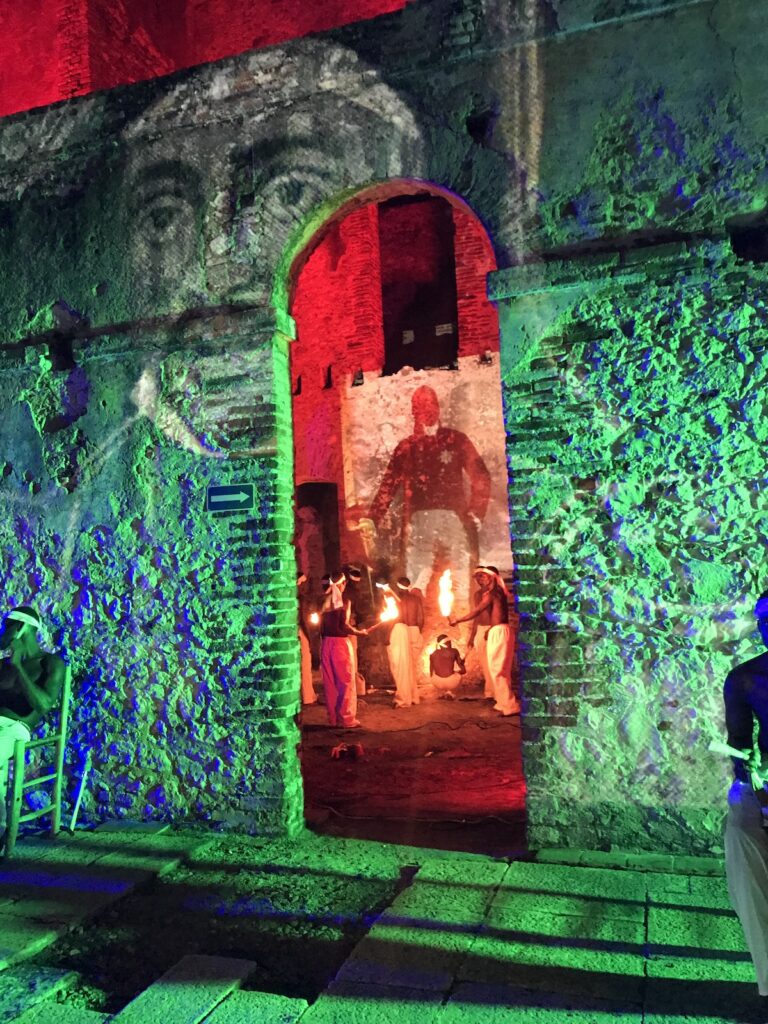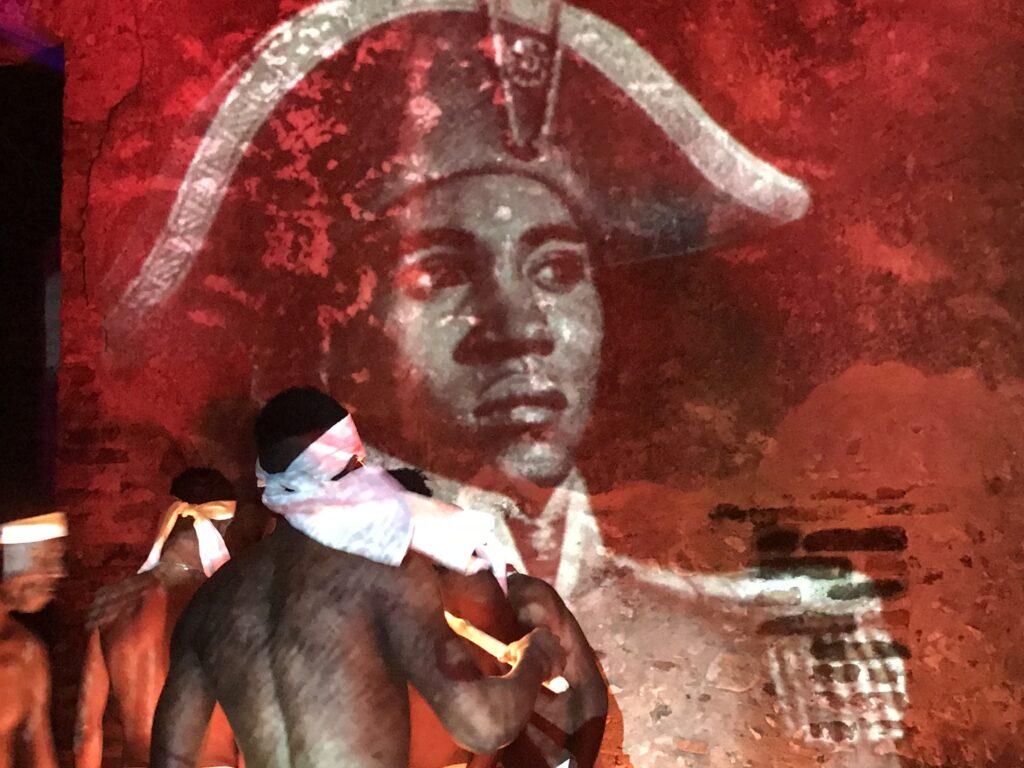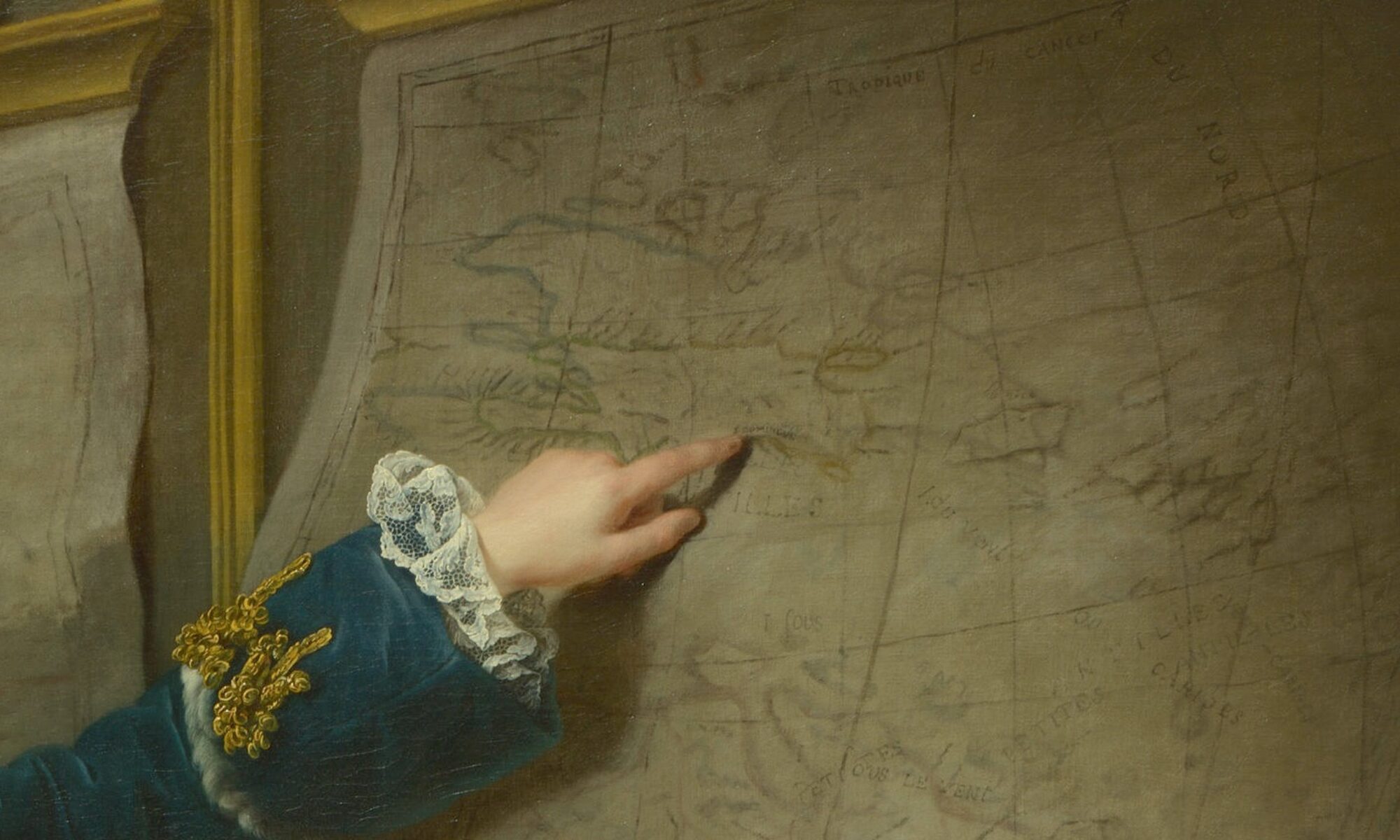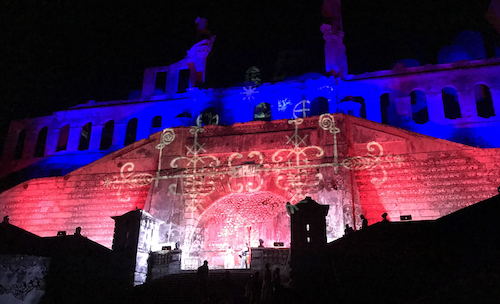Meredith Martin (NYU) and Hannah Williams (Queen Mary University of London)
Throughout 2025, we have had the honor and pleasure of working with the Haitian-born international digital and video artist, Maksaens Denis. Maksaens generously agreed to work with us to produce an animation and digital collage which will feature as the introduction and framing design for our Critical Counter Map. From the beginning, Maksaens was deeply engaged in the historical context surrounding the counter map and intuited what we are seeking to do through this remapping project. We learned so much from him and are grateful that he contributed his time, energy, and creativity to the project. We would also like to thank Florence Alexis and Pascale Monnin, who introduced us to Maksaens and his work.
Maksaens’s contemporary art practice is deeply engaged with Haitian history and its multilayered complexity. He agreed to answer some of our questions about his creative process and broader interests. We have published the interview here with the questions we posed in English, the answers Maksaens gave in French, and our English translation of those responses. We have also included an artist biography and some examples from Maksaens’ historically embedded and visually arresting œuvre.

Artist Biography
Maksaens Denis is a visual artist, born and raised in Haiti, who currently lives between Haiti and the Dominican Republic. He is recognized for his activism through his artwork, creating works that speak of the dramatic economic and political situation experienced by the population in Haiti. His work deals with topics related to spirituality, Vodou, and the questions that surround it, and he is also interested in exploring homosexuality and same-sex love as well as the injustice and discrimination experienced by the LGBTQI community in Haiti. Denis’s work spans several disciplines, from installation to video art, photography, printmaking, and sculpture, and since the 90s, he has also acquired significant experience in Techno VJ-ing.
Denis is an established international artist who has exhibited worldwide in Europe, America, Africa, and Asia. He is the recipient of multiple international grants, awards, and fellowships, and is renowned as a pioneer in multi-media and digital art using mapping techniques in the Caribbean. Denis loves to play with the duality and contrast of images, and effortlessly combines a visual aesthetic inspired by electronic music, Vodou culture, and other sources. He collaborates with artists from diverse disciplines, including visual artists, filmmakers, photographers, poets, dancers, and performers, in residencies held in various countries worldwide.

Interview with Maksaens Denis
1. What can you tell us about the role that Haiti’s past plays in your work?
Avant de répondre directement à cette question il faudrait que j’explique ma surprise durant les premières années quand je suis arrivé en France, dans les années 90, de voir la méconnaissance totale de l’histoire d’Haïti (jadis colonie française de Saint Domingue) et de cette partie de leur propre histoire. Cette méconnaissance, voire cette ignorance d’une grande partie de la population française m’a tout de suite fait sentir qu’il y avait une volonté de cacher la vérité et, par racisme, de minimiser la révolution haïtienne, la victoire des Haïtiens et la 1ère grande défaite de Napoléon.
Ce constat m’a porté à réaliser en 2004 le documentaire “l’Arbre de la Liberté” expliquant l’histoire d’Ayiti du 14e au 19e siècle puis j’ai trouvé intéressant d’intégrer des images visuelles issues de mon documentaire dans mes performances video Live (Vj).
Before answering this question directly, I should explain how surprised I was during my first few years in France, in the 1990s, to see how little French people knew about the history of Haiti (formerly the French colony of Saint Domingue) and about this part of their own history. This lack of knowledge, or even ignorance, for a large part of the French population immediately made me feel there was a desire to hide the truth and, out of racism, to minimize the Haitian revolution, the victory of the Haitian people, and the first major defeat of Napoleon.
These observations led me to make the documentary “The Tree of Liberty” in 2004, explaining the history of Haiti from the 14th to the 19th century. I then found it interesting to incorporate visual images from my documentary into my live video performances (VJ).
2. How does your multilayered, multidisciplinary work as a digital and video artist lend itself to explorations of Haiti’s complex, interwoven histories?
Nous avons une histoire unique, magnifique, mal connue et aussi comme vous dîtes, des histoires complexes et entremêlées. Pour moi c’est important de montrer à chaque fois des bribes de notre histoire et le traitement multicouches que j’utilise souvent, est d’après moi très approprié pour montrer la complexité de nos histoires. Aussi, que ce soit dans mes performances ou dans mes créations plus plastiques j’aime bien qu’il y ait plusieurs niveaux de lecture. En ce sens, le contemporain peut parfois renvoyer au passé et vice-versa dans mes créations.
We have a unique, magnificent, little-known history and, as you say, histories that are complex and intertwined. For me, it is important to show snippets of our history each time, and the multi-layered treatment I often use is, in my opinion, very appropriate for showing the complexity of our stories. Also, whether in my performances or in my more visual work, I like there to be several levels of interpretation. In this sense, the contemporary can sometimes refer to the past and vice versa in my creations.
3. Have there been any specific encounters with historical or archival materials – artworks, documents, maps – that have shaped your artistic approaches or shifted your creative directions?
En 2003 quand j’effectuais mes recherches pour mon documentaire, j’ai trouvé très peu d’images d’archives. Ce sont souvent les même que je rencontrais dans les livres ou sur internet. Je me suis servi de quelques-unes mais pour pallier ce manque, je me suis tourné vers les œuvres de peintres haïtiens modernes et contemporains, principalement de la seconde moitié du XXe siècle, parmi lesquels Frantz Zéphirin, Serge Moléon Blaise, Jean Saint-Fleur et Jean-Baptiste Théard. A l’occasion d’une exposition de peintures haïtiennes à Pontarlier, France organisée par la Galerie Monnin en 2003 j’ai pu obtenir l’autorisation de filmer les peintures haïtiennes qui s’y trouvaient, racontant d’une manière très particulière l’histoire d’Haïti. Ces peintures se retrouvent dans mon documentaire mais ont aussi souvent été utilisées dans mes projections live avec musique électronique.
En 2020, la Fondation Haïti Jazz et l’UNESCO m’ont confié la réalisation d’un mapping sur les murs du palais Sans-Souci, qui a été accompagné d’une performance de Linda François et d’autres danseurs, avec une mise en lumière signée Pro-Fête. Pour créer la vidéo du mapping, j’ai pu utiliser des images de la bibliothèque d’archives en libre accès en ligne et libre de droits de la New York Public Library (NYPL Digital Collections). J’y ai trouvé des images d’archives d’Haïti que je n’avais vu nulle part ailleurs : dessins, gravures, peintures de nos héros de l’indépendance, photo des pièces gravées par le roi Christophe, à l’effigie de Makandal, etc… Puis pour ce travail pour la Contre carte, j’ai pu avoir accès aussi à d’autres images très intéressantes.


In 2003, when I was conducting research for my documentary, I found very few archival images. They were often the same ones I had come across in books or on the internet. I used a few of them, but to make up for the lack of material, I turned to works by modern and contemporary Haitian painters, mostly from the second half of the 20th century, among them Frantz Zéphirin, Serge Moléon Blaise, Jean Saint-Fleur, and Jean-Baptiste Théard. During an exhibition of Haitian paintings in Pontarlier, France organized by the Galerie Monin in 2003, I was able to obtain permission to film the Haitian paintings on display, which tell the story of Haiti in a very unique way. These paintings are featured in my documentary but have also often been used in my live projections with electronic music.
In 2020, the Haiti Jazz Foundation and UNESCO entrusted me with creating a mapping projection on the walls of the Sans-Souci Palace, accompanied by a performance by Linda François and other dancers, with lighting design by Pro-Fête. To create the mapping video, I was able to use images from the New York Public Library (NYPL Digital Collections), an online archive that is freely accessible and royalty-free. I found archival images of Haiti that I had never seen anywhere else: drawings, engravings, paintings of our independence heroes, photos of coins engraved by King Christophe, bearing the image of Makandal, etc. Then, for this work for the Counter Map, I was also able to access other very interesting images.
4. We’ve been so honored to engage collaboratively with you on our Critical Counter Map. What was your experience like developing this work? Either in terms of your reaction to the visual sources or to the historical themes you encountered with the project?
Cette proposition de travailler sur la “contre-carte historique” et la manière de montrer l’histoire de mon pays m’a tout de suite interpellé. J’ai senti encore une fois ce besoin, et cette fois cela ne venait pas de moi, de rétablir la vérité en faisant parler les images. Tout de suite après avoir été approché par Meredith Martin et Hannah Williams pour réaliser ce travail j’ai pu avoir accès à des documents d’archives très importants et bien documentés. J’ai été impressionné, surpris, honoré moi aussi, et tout de suite intéressé à travailler sur le projet. J’ai aussi pu avoir l’autorisation d’utiliser la création d’un autre artiste contemporain que j’admire, Raphael Barontini, dans l’œuvre ce qui m’a aussi honoré.
Dans l’ensemble j’ai senti que c’était un grand défi par rapport à l’importance du sujet. Mais ce qui m’a le plus plu, c’est le fait de résumer 3 siècles d’histoire d’Haïti en 12 secondes d’animation. Morceaux choisis, bien sûr. Tout n’y est pas.
This invitation to work on the Critical Counter-Map and to find a way to show the history of my country immediately appealed to me. Once again, I felt the need—and this time it didn’t come from me—to restore the truth by letting the images speak for themselves. Immediately after being approached by Meredith Martin and Hannah Williams to do this work, I was given access to very important and well-documented archival materials. I was impressed, surprised, honored, and immediately interested in working on the project. I was also given permission to use the work of another contemporary artist I admire, Raphael Barontini, in the project, which was also an honor.
Overall, I felt that it was a great challenge given the importance of the subject. But what I liked most was the fact that I was able to summarize three centuries of Haitian history in 12 seconds of animation. Selected pieces, of course. Not everything is there.
5. What responses do you hope to evoke in contemporary viewers encountering your work – especially regarding perceptions of Haiti’s past?
J’espère que ce travail va provoquer des interrogations, susciter la curiosité et va pousser les viewers à entrer dans les pages du site pour voir et comprendre l’histoire d’Haïti, une partie importante des histoires du capitalisme et du colonialisme et avoir une autre (meilleure) compréhension du passé.
I hope that this work will provoke questions, spark curiosity, and encourage viewers to visit the website to see and understand Haiti’s history, an important part of the histories of capitalism and colonialism, and to gain a different (better) understanding of the past.


Cite this post as: Meredith Martin and Hannah Williams, “Counter-Mapping Haitian History: An Artist’s Interview with Maksaens Denis,” Colonial Networks (September 2025), https://www.colonialnetworks.org/?p=899.

